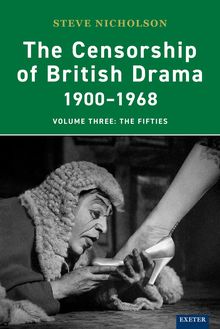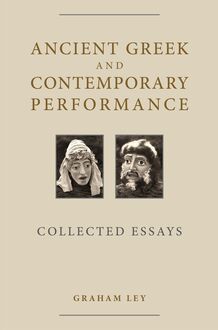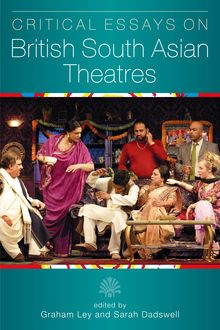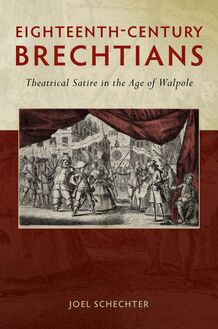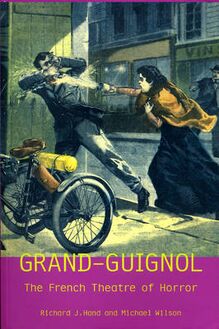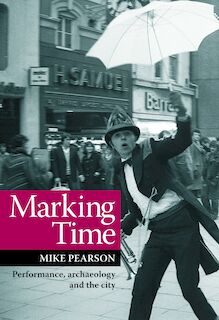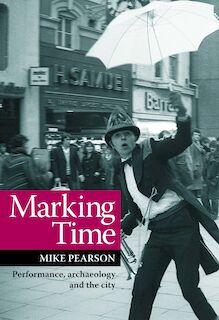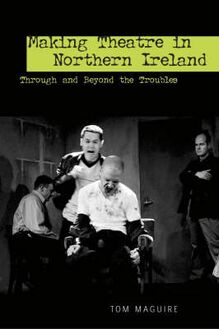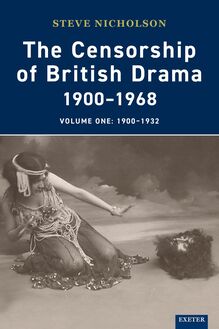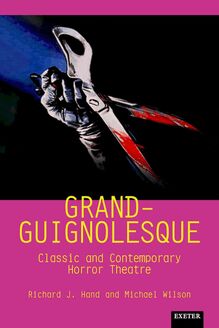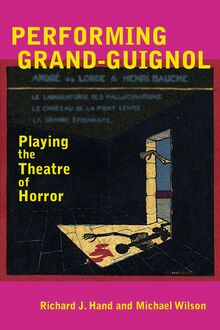-
 Univers
Univers
-
 Ebooks
Ebooks
-
 Livres audio
Livres audio
-
 Presse
Presse
-
 Podcasts
Podcasts
-
 BD
BD
-
 Documents
Documents
-
- Cours
- Révisions
- Ressources pédagogiques
- Sciences de l’éducation
- Manuels scolaires
- Langues
- Travaux de classe
- Annales de BEP
- Etudes supérieures
- Maternelle et primaire
- Fiches de lecture
- Orientation scolaire
- Méthodologie
- Corrigés de devoir
- Annales d’examens et concours
- Annales du bac
- Annales du brevet
- Rapports de stage
La lecture à portée de main
Vous pourrez modifier la taille du texte de cet ouvrage
Découvre YouScribe en t'inscrivant gratuitement
Je m'inscrisDécouvre YouScribe en t'inscrivant gratuitement
Je m'inscrisEn savoir plus
Vous pourrez modifier la taille du texte de cet ouvrage
En savoir plus

Description
While the infamous Théâtre du Grand-Guignol in Paris closed its doors in 1962, the particular form of horror theatre it spawned lives on and has, moreover, witnessed something of a resurgence over the past twenty years. During its heyday it inspired many imitators, though none quite as successful as the Montmartre-based original. In more recent times, new Grand-Guignol companies the world over have emerged to reimagine the form for a new generation of audiences. This book, the fourth volume in University of Exeter Press’s series on the Grand-Guignol by Richard J. Hand and Michael Wilson, examines the ongoing influence and legacy of the Théâtre du Grand-Guignol through an appraisal of its contemporary imitators and modern reincarnations.
As with the previous volumes, Grand-Guignolesque consists of a lengthy critical introduction followed by a series of previously unpublished scripts, each with its own contextualizing preface. The effect thereof is to map the evolution of horror theatre over the past 120 years, asking where the influence of the Grand-Guignol is most visible today, and what might account for its recent resurgence. This book will be of interest not only to the drama student, theatre historian and scholar of popular theatre, but also to the theatre practitioner, theatregoer and horror fan.
Contents
Preface
Chapter 1. Establishing the Grand-Guignolesque
Chapter 2. The Grand-Guignol’s Contemporary Imitators and Competitors
Chapter 3: The New Wave
Chapter 4: Afterword
Appendix: The Molotov Manifesto, or Acting Grand Guignol, Molotov Style
Thirteen Plays of Grand-Guignol and the Grand-Guignolesque
Professor Verdier’s Operations (Les Opérations du Professeur Verdier, 1907) by Élie de Bassan
Short Circuit (Le Court-Circuit, 1916) by Benjamin Rabier and Eugène Joullot
The Little House at Auteuil (La Petite Maison D’Auteuil, 1917) by Robert Scheffer and Georges Lignereux
The Unhinged (Les Détraquées, 1924) by Palau and Olaf
The Eyes of the Phantom (Les Yeux du Spectre, 1924) by Jean Aragny
The Lover of Death (L’Amant de Mort, 1925) by Maurice Renard
Orgy in the Lighthouse (L’Orgie dans le phare, 1956) adapted by Eddie Muller from Alfred Machard’s play
The Sticking Place (2008) by Lucas Maloney and Michael McMahon, with Alex Zavistovich
A Room With No View (2009) by James Comtois
The Ghost Hunter (2013) by Stewart Pringle
We’ll Fix It! (2013) by Les Williams
Leviticus: Evil Resides Within (2014) by Antonio Rimola
Abel Hartmann's Grand-Guignol: A History of Violence (2015) by Dreamcatcher Horror Theatre
Bibliography
Webography
Index
Sujets
Informations
| Publié par | University of Exeter Press |
| Date de parution | 27 septembre 2022 |
| Nombre de lectures | 0 |
| EAN13 | 9781804130162 |
| Langue | English |
| Poids de l'ouvrage | 2 Mo |
Informations légales : prix de location à la page 0,1900€. Cette information est donnée uniquement à titre indicatif conformément à la législation en vigueur.
Extrait
Grand-Guignolesque
Exeter Performance Studies
Series Editors:
Helen Brooks, Reader in Theatre and Cultural History, University of Kent Jane Milling, Professor in Drama at the University of Exeter Steve Nicholson, Emeritus Professor, University of Sheffield Duška Radosavljević , Reader in Contemporary Theatre and Performance, Royal Central School of Speech and Drama, University of London
Exeter Performance Studies explores performance in relation to historical context. The series is a home for a wide variety of work engaging with processes of making and doing, as well as materiality, policy and cultural practice. It publishes the best new scholarship, presenting established authors alongside pioneering work from new scholars, including titles which provide access to previously unavailable material and engage in processes of decolonisation and methodological innovation.
Selected previous titles:
London’s Grand Guignol and the Theatre Of Horror , by Richard J. Hand and Michael Wilson
Performing Grand-Guignol: Playing the Theatre of Horror , by Richard J. Hand and Michael Wilson
Grand-Guignol: The French Theatre of Horror , by Richard J. Hand and Michael Wilson
From Mimesis To Interculturalism: Readings of Theatrical Theory Before and After ‘Modernism’ , by Graham Ley
Critical Essays on British South Asian Theatre , by Graham Ley and Sarah Dadswell
Theatres of the Troubles: Theatre, Resistance and Liberation in Ireland , by Bill McDonnell
First published in 2022 by
University of Exeter Press
Reed Hall, Streatham Drive
Exeter EX4 4QR
UK
www.exeterpress.co.uk
© Richard J. Hand and Michael Wilson 2022 for editorial material and translations
The right of Richard J. Hand and Michael Wilson to be identified as authors of this work has been asserted by them in accordance with the Copyright, Designs and Patents Act 1988.
Play texts
© Eddie Muller 2010 for Orgy in the Lighthouse adaptation
© Lucas Maloney and Michael McMahon with Alex Zavistovich 2008
for The Sticking Place
© James Comtois 2009 for A Room with No View
© Stewart Pringle 2013 for The Ghost Hunter
© Les Williams 2013 for We’ll Fix It!
© Antonio Rimola 2014 for Leviticus: Evil Resides Within
© Dreamcatcher Horror Theatre 2015 (CC-BY-NC) for Abel Hartmann’s Grand Guignol: A History of Violence
All performing rights in these plays are strictly reserved and application for performance rights should be made in writing to the publishers.
Exeter Performance Studies
British Library Cataloguing in Publication Data
A catalogue record for this book is available from the British Library.
https://doi.org/10.47788/EQDI2918
ISBN 978-1-80413-015-5 Hardback ISBN 978-1-80413-080-3 Paperback
ISBN 978-1-80413-016-2 ePub
ISBN 978-1-80413-017-9 PDF
Cover image: adapted from Licence to Thrill’s poster for ’Tis the Season 2016 © Les Williams
Every effort has been made to trace copyright holders and obtain permission to reproduce the material included in this book. Please get in touch with any enquiries or information relating to an image or the rights holder.
To the Grand-Guignoleurs of the world, past, present and future…
Contents
List of Illustrations
Acknowledgements
Preface
Part One: An Overview of Classic and Contemporary Horror Theatre
1 Establishing the Grand-Guignolesque
2 The Grand-Guignol’s Contemporary Imitators and Competitors
3 The New Wave
4 ‘The Molotov Manifesto’
Part Two: Thirteen Plays of Grand-Guignol and the Grand-Guignolesque
Professor Verdier’s Operations ( Les Opérations du Professeur Verdier , 1907 )
by Élie de Bassan
Short Circuit ( Le Court-Circuit
by Benjamin Rabier and Eugène Joullot
The Little House at Auteuil ( La Petite Maison D’Auteuil , 1917)
by Robert Scheffer and Georges Lignereux
The Unhinged ( Les Détraquées , 1921)
by Palau and Olaf
The Eyes of the Phantom ( Les Yeux du Spectre , 1924)
by Jean Aragny
The Lover of Death ( L’Amant de Mort , 1925)
by Maurice Renard
Orgy in the Lighthouse ( L’Orgie dans le phare, 1956)
adapted by Eddie Muller from Alfred Machard’s play
The Sticking Place (2008)
by Lucas Maloney and Michael McMahon, with Alex Zavistovich
A Room With No View (2009)
by James Comtois
The Ghost Hunter (2013)
by Stewart Pringle
We’ll Fix It! (2013)
by Les Williams
Leviticus: Evil Resides Within (2014)
by Antonio Rimola
Abel Hartmann’s Grand-Guignol: A History of Violence (2015)
by Dreamcatcher Horror Theatre
Bibliography
Webography
Index
Illustrations
1 Pierre Palau and Jean Velu’s Une Main dans l’ombre ( A Hand in the Shadows ), a horror play about revenge, Le Théâtre des Deux Masques, May 1923, Le Théâtre et Comoedia Illustré No. 19, July 1923 (out of copyright)
2 Yoris d’Hansewick’s Pâques juives ( Jewish Easter ), a horror play about antisemitic brutality and revenge, Le Théâtre des Deux Masques, July 1923, Le Théâtre et Comoedia Illustré No. 26, September 1923 (out of copyright)
3 Thrillpeddlers, poster for Shocktoberfest 13: The Bride of Death (image credit: Flynn DeMarco)
4 Thrillpeddlers, production still, The Orgy in the Lighthouse , 2000 (photo credit: David Allen)
5 Molotov Theatre Group, poster for Blood, Sweat and Fears , 2016 (copyright Alex Zavistovich)
6 Licence to Thrill, poster for ’Tis the Season 2016 (copyright Les Williams)
7 Tin Shed Theatre Company, poster for Dr Frankenstein’s Travelling Freakshow , 2012 (copyright Tin Shed Theatre Company)
Acknowledgements
We would like to express our heartfelt thanks to the numerous writers, directors, producers, actors and other aficionados of the Grand-Guignol who have made this volume possible. The number of people who have helped us through interviews, informal conversations, letters and email correspondence, as well as by giving us access to archival materials and inviting us to performances, are far too numerous to mention individually, but you know who you are, and we are immensely grateful for your enthusiastic support and enormous generosity.
We would also like to thank our colleagues and students at the University of East Anglia and Loughborough University and, as always, our erstwhile collaborators in the Grand-Guignol Laboratory we established at our former institution where this long journey began: the University of South Wales (formerly the University of Glamorgan).
Preface
It is now more than twenty years since we first started to research the Théâtre du Grand-Guignol * —that most intimate of theatres, half-hidden at the end of a dark alleyway in the red-light district of Pigalle in Montmartre, Paris—and the particular blend of horror, comedy and eroticism for which it became famous during its sixty-five-year life from 1897 to 1962. Since then, we have written three books (this being the fourth) and several articles, translated and adapted numerous plays from the French, run workshops, given talks, had long discussions (often involving beer and occasionally tartare de boeuf , that most Grand-Guignolesque of dishes), staged performances, spilled (fake) blood, and directed, performed and watched many plays with several generations of students.
In the introduction to our first book ( Grand-Guignol: The French Theatre of Horror , 2002) we claimed that the Théâtre du Grand-Guignol was one of the world’s great forgotten theatres. We don’t think that was any exaggeration. At the time there was Mel Gordon’s survey book The Grand Guignol: Theatre of Fear and Terror , which had recently gone out of print (now republished in a revised edition), and a handful of short articles in academic journals, but that was the limit of the literature in English on the subject. Agnès Pierron’s large collection of scripts had also been recently published in French but was not widely known in the UK.
Despite its subsequent neglect, the Grand-Guignol had an international reputation during its lifetime, frequented and loved by the Montmartrean underclass, as much as the crowned heads and leading diplomats of Europe. It was a favourite with the occupying German forces during the Second World War and then equally so with the liberating Allies in 1944. It was on the ‘must-do’ list, along with the Eiffel Tower and the Louvre, of every self-respecting tourist to Paris in the first half of the twentieth century.
This volume presents another way of assessing the importance of the Grand-Guignol by looking at its contemporaneous imitators and the long shadow of its influence. What we have tried to do is to assess the influence of the Grand-Guignol and the state of play of current horror performance, focusing principally upon experiments and enterprises in the UK and the USA. While the original Théâtre du Grand-Guignol has long since closed its doors and the actors who trod the boards in the rue Chaptal have all but made their exit, attempts at reviving the form have come and gone with varying degrees of success.
* As with our previous books, we have adopted the convention of using the hyphenated Grand-Guignol when referring to the specific theatre in the rue Chaptal and as the default spelling when referring to the genre more generally. We have used the non-hyphenated Grand Guignol when either a citation demands it, or when referring specifically to the London Grand Guignol or other manifestations where the hyphen has not been used in official publicity.
Part One
An Overview of Classic and Contemporary Horror Theatre
1
Establishing the Grand-Guignolesque
Despite the demise of the Grand-Guignol, the cultural form of horror has never gone away. Across all art forms and media, horror has been a major genre for the remainder of the twentieth century and into the twenty first. An interesting case in point is Hammer Films, a doyen of British cinema that enjoyed international success with its distinctive brand of ‘Hammer Horror’. Although it had existed as a film company since the 1930s, it was with films such as The Quatermass Experiment (1955), The Curse of
-
 Univers
Univers
-
 Ebooks
Ebooks
-
 Livres audio
Livres audio
-
 Presse
Presse
-
 Podcasts
Podcasts
-
 BD
BD
-
 Documents
Documents
-
Jeunesse
-
Littérature
-
Ressources professionnelles
-
Santé et bien-être
-
Savoirs
-
Education
-
Loisirs et hobbies
-
Art, musique et cinéma
-
Actualité et débat de société
-
Jeunesse
-
Littérature
-
Ressources professionnelles
-
Santé et bien-être
-
Savoirs
-
Education
-
Loisirs et hobbies
-
Art, musique et cinéma
-
Actualité et débat de société
-
Actualités
-
Lifestyle
-
Presse jeunesse
-
Presse professionnelle
-
Pratique
-
Presse sportive
-
Presse internationale
-
Culture & Médias
-
Action et Aventures
-
Science-fiction et Fantasy
-
Société
-
Jeunesse
-
Littérature
-
Ressources professionnelles
-
Santé et bien-être
-
Savoirs
-
Education
-
Loisirs et hobbies
-
Art, musique et cinéma
-
Actualité et débat de société
- Cours
- Révisions
- Ressources pédagogiques
- Sciences de l’éducation
- Manuels scolaires
- Langues
- Travaux de classe
- Annales de BEP
- Etudes supérieures
- Maternelle et primaire
- Fiches de lecture
- Orientation scolaire
- Méthodologie
- Corrigés de devoir
- Annales d’examens et concours
- Annales du bac
- Annales du brevet
- Rapports de stage
